
- Home
- Item Height
- Item Length
- Item Width
- Material
- Abs+aluminium Alloy (13)
- Alloy (29)
- Alloy, Steel (8)
- Aluminium (131)
- Aluminium Alloy (94)
- Aluminum (17)
- Aluminum Alloy (158)
- Canvas (58)
- Canvas, Leather (12)
- Chromoly (6)
- Iron (8)
- Metal (14)
- Nylon (16)
- Plastic (159)
- Polyester (24)
- Polyster (9)
- Pu, Oxford Cloth (7)
- Pullable Fabric (9)
- Regular (26)
- Steel (118)
- ... (1724)
- Size
- 17-35l (2)
- 24x15cm (2)
- 3 Bike (3)
- 32.00*22.00*20.00cm (2)
- 33x33x14cm (3)
- 345x140x202mm (2)
- 38x19cm (7)
- 4 Bike (2)
- 40x30cm (3)
- 48.5cmx14cmx44.5cm (3)
- 50x14cm (4)
- 55cm X 21cm (59)
- Extra Large (8)
- L365*w150*h75mm (7)
- L365*w150*h82mm (8)
- Large (51)
- Medium (15)
- One Size (11)
- Remains, (2)
- Universal (2)
- ... (2444)
- Type
- $st_type$ (25)
- Backpack (18)
- Battery (16)
- Bicycle Rear Rack (64)
- Bike Carrier (218)
- Bike Rack (19)
- Boot Mounted (53)
- Carrier Rack (113)
- Child Seat (11)
- Clincher Tyres (15)
- Conversion Kit (17)
- Double Pannier Set (51)
- Fat Tyres (17)
- Rack Pack / Bag (44)
- Rear Bike Rack (11)
- Rear Rack (57)
- Surfboard Rack (31)
- Tubular Tyres (15)
- Vehicle_bag (16)
- 18650 (20)
- ... (1809)
Custom Ridgeback Randonneur 650b 30sp Reynolds 55cm Reynolds Deore Surly Tubus

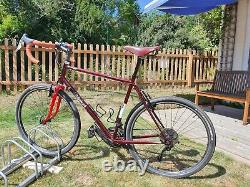
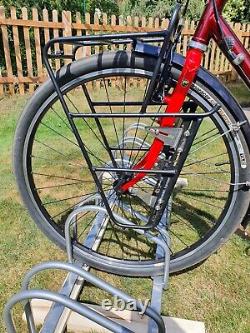





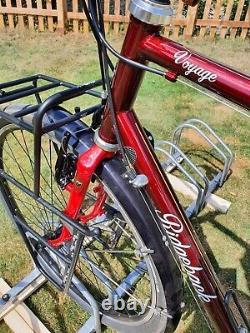
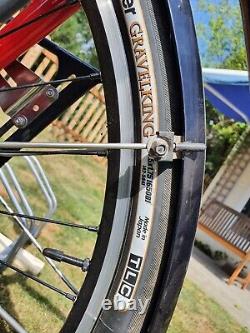
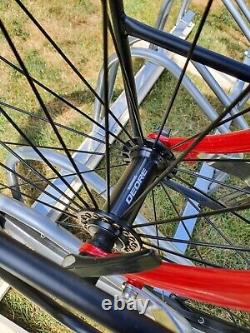
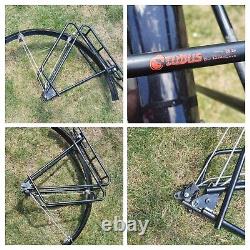


I do this in my spare time, and I use a combination of new and good used parts. I ride the bikes I build, but usually only to the point that they are "bedded in" and I've satisfied my curiosity about how they perform.
Past bikes have featured Rohloff hub gears in various configurations in alloy mountain bike and trekking frames. More recently I've built and tried out a succession of fast road and gravel bikes.
Most times, I reckon my bikes are the equal of all but the most expensive custom-built bikes out there. But now for something slightly different. For a while I'd wanted to build a modern version of the " randonneur " road bikes which first became popular in France in the 1950s, Randonneurs are now enjoying something of a resurgence. Many bike builders and riders, including Jan Heine who has revived the famous Rene Herse brand, have re-popularised these practical, efficient bikes and their many distinctive features. Randonneurs were not "touring bikes" as we understand them now. They were built for swift, efficient long-distance riding, often in rally-style "brevets" or "randonnees", popular before the second world war, but which flourished in the post-war era, in the 1950s and 1960s. With specified checkpoints and time targets but no outright competitive element, these " audax" events were the mass participation sporting events of the time, predating the jogging movement of the 1970s and the city marathons that arose later. The most famous of all r andonnées, the 1200km Paris-Brest-Paris, continues to this day. It is only one of hundreds of Audax events and "brevets" in the calendar, which now includes the modern sportive too. In the post-war period the bikes that became known as randonneurs were built with as much care and attention as the the out-and-out racing bikes of the time. They evolved to be comfortable for long periods, to use a wider range of gears, and to allow the carrying of spares, food, clothing and lights. They ran on wider tyres, usually in the continental 650b size, to cope with the varied road surfaces of the time. Mudguards were essential, as was some kind of effective lighting. Riders had to be be self-supporting, so these bikes had to carry bags, either under the saddle or on the handlebars.For riders covering hundreds of kilometres over several days, it was for more important that their bikes be comfortable, stable and efficient: ultimate speed or weight in themselves were less important. In long distance riding the critical factor is often the time spent on stops, and comfort is paramount.
I wanted to combine the features of these post-war marvels with the many modern developments which have improved bike performance and practicality in the fifty-odd years since the randonneur first appeared. This bike would retain the key elements of the original concept - a steel frame, larger 650b tyres, derailleur gears, mudguards, room for luggage, drop bars, a comfortable riding position and stable steering. I wanted the bike to be able to carry serious touring loads, but also to be a capable and entertaining day bike too. The result, I hoped, would be more than just an updated old-school touring bike, and so it has proved. Frame: After a long search, I found a new and unused Ridgeback World Series frame which was very much "modern randonneur ".
It was, I was told, an experimental version that had been built expressly for 650b wheels. When I measured it, I found 73° head and 74° seat angles, more akin to a fast road bike than a tourer. It had a sloping top tube, slightly longer chainstays, and a lower-than-usual 9.75 bottom bracket. Still in character, it had three sets of bottle bosses, down tube gear lever bosses and cable runs, and, as advertised, cantilever pivots sited for 584mm wheels - the classic 650b size. The frame even has old-school pump and chain pegs on the left and right chainstays.
As built now, the key dimensions are (in mm). For a complete (and I mean really complete) set of measurements for the completed bike, you can go to the Bike Geometry Calculator website, using this URL. Forks: I chose a Thorn Super Touring fork that I've had in the cupboard for a while. It is made with Reynolds tubing, and its 46mm offset provides for 50mm of trail, more of which later. A steel fork is true to the randonneur tradition (and the rest of the frame) but, as you see in the pictures, this one allowed me to fit 42mm tyres, mudguards and a superb Surly Nice 2.0 Cromoly front rack - capable of taking over 30kg if required.
The fork had some chips in the red Imron paint finish from knocking around the workshop, but it had never been used in anger and will outlast all of us, as will the oversize Tioga sealed-bearing headset. The fork has a 360mm steerer tube which allows for a wide range of bar height adjustment, too.
Wheels on any bike are a defining feature. Again I set out to follow the randonneur tradition, but with modern components.
Shimano Deore hubs are laced with thirty-two black JTek 14g plain-gauge stainless spokes to SJS 650b 19mm rims with stainless eyelets and machined brake surfaces. I built these wheels myself on a Park Tool precision truing jig, using a dishing gauge and spoke tension meter. The spoke heads are supported by SAPIM brass washers, ensuring a super-snug fit of spoke to hub flange.
This should increase the fatigue life of spoke and hub flange alike. The wheels are true to within +/- 1mm,, and should stay that way for a good while.
Again in randonneur tradition the Deore hubs have adjustable cup-and-cone bearings, but with efficient labyrinth seals and a modern 10 speed-compatible freehub. The result is a pair of smart, light, resilient wheels, true to the randonneur tradition, built to last and with perhaps a little more style than the norm. Sidebar 1 I chose to build these wheels with radial spoking on both the front wheel and the non-drive side at the rear. Radial spoking is not a Randonneur tradition as far as I'm aware, but was not unusual on touring bikes in the UK in the 70s and 80s when I was growing up. There are some scare stories out there on the forums, but usually with low-volume lightweight hubs in the 90s and noughties.
Often the hub shells, including the flanges, were machined from alloy bar stock and did not have the ultimate strength of forged one-piece hub shells that high-end manufacturers were then using. The problem has largely gone away now, courtesy of newer aluminium alloys that are used more widely today. Certainly I've built and used radially spoked wheels for many years now, not least because they are easier to build and true, are lighter, and place less stress on the rim ferrules, where many more wheels fail in the end. The other requirements for this "New Randonneur" were durable, smooth-changing gears and first class brakes.
Gearing is a modern "Shimergo" setup, using ten speed Campagnolo Veloce Ergo levers with Deore "Shadow" mountain bike derailleurs, Hollowtech Deore triple chainset and 10 speed cassette. A Jtek ShiftMate allows Campag levers and Shimano groupset to work together perfectly and the changing is as good as any manual setup I've used. I prefer the Campag levers to the Shimano equivalents. They are more comfortable, and I've always found the Campag shift lever set-up more intuitive than the Shimano one. The LH shifter in this case uses the pre-2008 Campag micro-adjust mechanism. This isn't really indexed in the full sense, but instead allows small adjustments in the front shifter. This allows you to tune the mech position, reducing cage rub particularly for triple chainsets as here. The cassette is an 11-36 Deore XT cluster, which, with the 26-36-46 chainrings gives a gear range of 19" to 105" - about 550% overall. Gear chart using Gear Inches.For 650 x 38B / 38-584 / 650B tire with 175 mm cranks. With Shimano 11-13-15-17-19-21-24-28-32-36 10-speed bk Cassette.
This set up gives me more than enough gears to work with, certainly to get up our local Shropshire 1-in-5s, even with racks, panniers and a decent camping load. The long chainstays mean you can use all but the most extreme gear combinations, and I regularly use all ten rear sprockets with the middle chainring, for example, which gives an.Sidebar 2: Why not a 1X set-up or a 2X sub-compact? For me, the steps in a 1X are too wide for comfortable use on the road, when closer ratios across the cassette allow much better matching of gradient and conditions to the steady (and in my case feeble) power output you should try to maintain on longer rides.
1X is a great idea for mountain bikes and must really appeal to people who are coming to cycling for the first time. But when I started out in the 1970s even six-speed freewheels were a luxury and you had to have a triple chainset if you wanted a decent range of gears without humongous jumps between them. I don't mind the complexity of a triple, and I appreciate the ability to fine-tune gear to energy to gradient, particularly if I can do so quickly without taking my hands of the hoods. Anyway these days, changers, chainrings and chains are much more durable and continue to work very well for much longer than they ever used to.
Good lubricants and some care and attention are all that's needed. In the workshop I had sets of old-school Shimano and Dia-Compe cantilevers.
Cantis are out of fashion but can be highly effective, as they are on my workhorse'80s Coventry Eagle Touristique. And though v-brakes are ultimately better in most respects, they can't be used out of the box with road bike levers.But there is a way: I've used Box 2 BMX V-brakes with Travel Agent-style cable travel compensators. These make it possible to use conventional drop-bar levers while retaining modulation and stopping power.
The Box brakes are beautifully finished, super-rigid and easy to adjust. They have a further advantage in the form of a 50mm pad height range which, along with the generous frame and fork clearances, would allow you to fit 700c wheels if you ever felt the need.
The BGC datasheet (see below) includes pretty much every dimension you could possibly want, not just those in specifications provided by manufacturers. Broadly speaking, this bike will suit most people between about 5'8 and 6'.
As shown in the photos and in the datasheet measurements, the bike is set up for me, an average sized 5'11" man with a 32" inside leg. I'm at the upper range of people this bike would suit.I reckon it would work just as well or even better for someone in the 5'7"-5'10" range. I use standover height as an effective lower limit when sizing a frame. This bike has a standover height of 790mm or 31.
This is less than it's seat tube length would suggest, due to the lower bottom bracket height. All the same, if your inside leg measurement, crutch to floor, is less than 31, then this probably isn't the bike for you. If you have a bike that fits you well, that should serve as a starting point to see if you can achieve the same fit on this bike.You may need a different stem for example, though for what it's worth, this bike uses a steerer sleeve, and the stem that can be adjusted up and down very quickly with just a 5mm allen key. I often move the stem up and down depending on the kind of ride I'm on, or whether I'm going to be working into a headwind all day.
In the end fit is about riding style and personal preference. Please make sure this bike is going to be the right size for you.
I can't guarantee it will fit you, and I'm certainly not a bike fit expert. Contact points start with the flared Genesis 3.0 bars. These are 440mm across the hoods and 500mm across the drops, so a little wider at than the norm.There is a trade-off here. It used to be said you should use bars which, if you held them up, were roughly the same width as your shoulders. I'm fairly wide but even if you aren't, when you're touring, or riding steadily over a longer period, wider bars give you more options. And more leverage when the front end is loaded up with panniers.
I don't use the drops much these days: these ones are shallow and short, but they are a useful option, particularly into the wind. And the brake levers are still in easy reach. Hand comfort is a big point, and the bars have two layers of wrapping.
A rubber base layer courtesy of two pensioned-off inner tubes, then perforated composite bar tape on top. This gives a broader support for the hand as well as a little more cushioning.
Does it make a difference? I think so, though for me, the position and width of the brake hoods are just as important.I like the classic Campag Ergo levers. The later Campag and Shimano levers aren't the same, and until I can afford to go electric, I'll stick with these ones, which are easier and less fatiguing in use, and which offer more hand positions, to me anyway. At the other end I've fitted a new Brooks B17 Standard saddle. The Standard is broader than the classic leather saddle of yore, and the leather is thinner.
It suits a wider range of people, men and women alike. It is adjustable, more compliant, and the leather surface absorbs sweat more readily than other foam/coating combinations. In the long run, a well-fitting, broken-in leather saddle is less likely to produce some of the inflammations and issues that bedevil cyclists riding for long periods.If you have never tried a Brooks, this might be the time, but if you have a saddle that suits you just fine, let me know. I'll keep the Brooks and reduce the price accordingly. Pedals are the third point of contact. The XT pedals fitted to this bike combine platform and SPD fittings, with superb bearings and wide support and secure location in either mode.
If you don't use out-and-out cycling shoes, or you want to get off your bike from time to time but keep the option to use SPDs, these are the best, in terms of both support to the foot and in ultimate durability. Compliance is about how a bike transmits or damps out the shocks from the road or path as you travel over it. First, to dispel some myths.
A frame has no compliance, what ever anyone says, unless it has suspension of some kind. The only compliance you experience when riding comes from, in order of importance, the flex in your tyres, the flex in your fork blades, and lastly the flex in your saddle and handlebars. Tyres are by a long way the most important determinant of compliance, and now head of my list of importance on any bike. In recent years we've got a far better understanding of tyre weight, flexibility, width, pressure, tread and profile and their combined effect on real-world rolling resistance. The revelations have been remarkable: wider tyres are by no means slower, and optimum tyre pressure is much lower than we had all thought: the bone-hard ride from 120psi 23mm racing tyres just gave the illusion of speed, at the cost of vastly greater fatigue and wear and tear, not least on riders. Gravel racers now regularly run tyres as wide as 60mm, with pressures as low as 15psi. Any aerodynamic losses are as nothing compared with the improvements in rolling resistance and comfort. So this bike comes with super-light, 350g 42mm Panaracer Gravelkings. These tyres easily won their category in Bierman's rolling resistance tests.I've used them extensively, and have settled on Schwalbe SV21A lightweight presta valve tubes, at around 30psi. The ride quality is superb but so is the traction. Puncture resistance is far better than you might think: there is something here about the low pressures preventing outright penetration from sharp objects, I'm sure. You could run this wheel-tyre combination tubeless, too: you'd need a Stan's kit but it would work.
Condition This bike, like all the bikes I build, is made up using new and used parts. As it happens, this one looks pretty much like a new bike: there are small chips and scratches if you look, but nothing rough or unfinished. Cables, chain, brake blocks, wheels, tyres and tubes are all new or at the most a couple of months old. The oldest items on the bike are the Campagnolo Ergo levers, which are probably fifteen years old - but they too are in good nick and certainly they function perfectly. Like everything else, they have been stripped down, cleaned and lubricated before fitting.
I'm usually around at weekends, and sometimes during the week. We're in central Shrewsbury, and if you'd like to do this, get in touch. Ridgeback World Series Voyager frame. Braze on fittings for 3x bottle cages, front and rear racks, mudguards, pump (seatstay), chain retainer.
Cable guides, downtube lever bosses. V/Cantilever brake bosses sited for 650b wheels. Bosses for mudguards, rack, dynamo.
Clearance for 650B x 45 with mudguards, 50 without. Wheels - new, hand-built using professional truing jig, offset gauge, spoke tension meter etc.SJS 650B 32h alloy rims. DT Swiss 14g spokes with 2BA brass spoke head washers. Rear laced 3x drive side, radial non-drive side. Panaracer Gravelking 650x 43c semi-slick tyres. Schwalbe 21A lightweight inner tubes.
Shimano XT HollowTech 2 sealed bearing bottom bracket. Shimano Deore triple chainset (46/36/26), alloy rings.
Shimano Deore triple front derailleur. Deore Triple Mountain rear derailleur. Campagnolo Veloce 10spd brake levers/shifters.
JTek ShiftMate cable pull adjuster. New stainless cables, Jagwire outers, ferrules. LitePro cable pull adjusters (enables use of road brake levers with direct-pull brakes). New stainless cables, Jagwire outers, ferrules etc. Brooks B17 Standard saddle (or other saddle by arrangement).
Seatpost - Alloy Microadjust 27.2mm. Ritchey 46mm Touring handlebars 31.8mm.
Shimano XT double-sided SPD/platform pedals. Front - Surly Cromoly 2.0, four-point mounting to fork bosses.
Rear - Tubus Logo Evo. 3 x alloy bottle cages. 50mm SKS chromoplastic mudguards (mounted to rack at rear and removable in one piece).
This item is in the category "Sporting Goods\Cycling\Bikes". The seller is "argyller" and is located in this country: GB. This item can be shipped to United Kingdom.
- Handlebar Type: Drop Bar
- Wheel Size: 650B
- Bike Type: Touring Bike
- Material: Steel
- Number of Speeds: 30 Speed
- Vintage: No
- Colour: Brown
- Brand: Ridgeback
- Department: Unisex Adults
- Type: Clincher Tyres
- Custom-Built: Yes
- Brake Type: V-Brake (Direct/Linear Pull)
- Manufacturer Warranty: None
- Suspension Type: No Suspension
- Model: World Series
- Shifter Style: Road Bike Shifter
- Features: Adjustable Seat, Bottle Cage, Front Bike Rack, Mudguards, Rear Bike Rack
- Gear Change Mechanism: Derailleur Gears
- Frame Size: Medium

